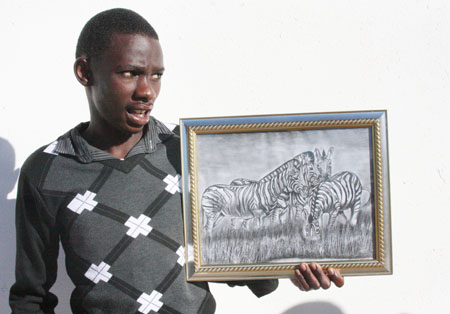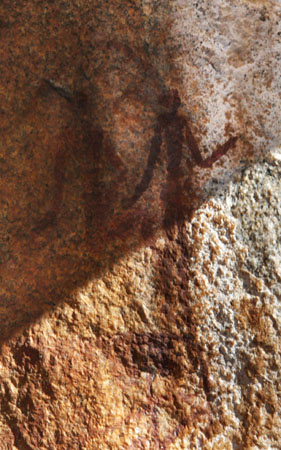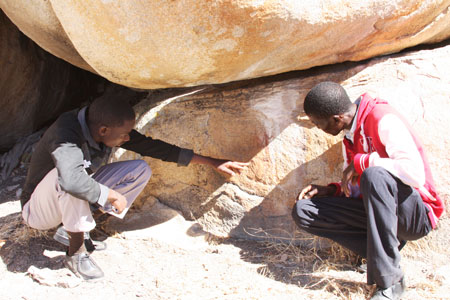Mosie talks re-writes history
13 Aug 2013
Ordinarily, you would never find a 21-year-old guide, whose mission and role is to take local and international tourists to some of the country’s hidden and sometimes eerie treasures.
Such wisdom is often the exclusive preserve of few wise men and women who are highly regarded in society as walking dictionaries of indigenous knowledge in any village or locality.
In the absence of any record of a particular cultural heritage or site, all eyes look to the grey-headed to avoid getting incorrect information from unreliable sources.
Unlike the youth, the elderly are also believed to be cautious and do not in any way do or say anything that might upset the ancestors at such cultural sites.
They obey cultural rites and myths without questioning.
However, a young man of Masingwaneng in the North East District, Mr Goitsemang Mosie, is daring to venture where many youth would not dare, and in the process, rewriting history while also talking about it.
Mosie is an employee of the Botswana National Museum, Monuments and Art Gallery as a local guide for the Ntimbale rock paintings, a tourist attraction discovered during the construction of the mammoth Ntimbale dam near Masingwaneng.
The paintings, which are situated at various spots near the dam, tell the history of the early inhabitants of the area who are believed to have been the San, says Mr Mosime in an interview.
The young man’s role is to guide tourists around the area, which is still being developed into a tourist and cultural heritage site.
He explains that nine sites with rock paintings were discovered during the construction of the dam.
However, only four remain now after the other five were submerged in water becoming part of the dam.
He indicates that his employees are working hard to develop the area and have it up and running as soon as possible, noting that signage guiding one to the sites is already in the pipeline.
The rocks where the paintings are have been fenced and the hope is that they will be sealed and secured with padlocks for security purposes.
There are still some cattle posts in the area although Mr Mosie indicates that government has secured the land, which was previously privately owned, and the hope is that once proper developments are carried out, they will make way.
This youngster, who completed his secondary education at Mater Spei College, landed the local guide job after an interview and started his career guiding tourists through the Ntimbale rocks in September last year.
A talented artist himself, Mr Mosie says he learnt the use of brush and pencil to create outstanding art pieces from his cousin.
And the rock paintings seem to awaken that creative spirit within him too.
He obtained a ‘C’ grade for the subject at junior secondary school before doing much better with an ‘A’ star at senior school, and he never looked back thereafter.
The young man gets his off days on Thursdays and Fridays and uses the opportunity to advance his art by painting and drawing, sometimes at the request of the locals.
He is also good at graphic design and often does a bit of T-shirt printing for fellow residents.
“I tried my luck in the President’s Day Art Competitions but did not do well. My hope is to enter again next year with much improved artworks,” he says.
Perhaps it is this passion for art that landed him the local guide job.
The few tourists he has taken to the sites appreciate his knowledge of the paintings, which is from time to time sharpened by having conversations with the older tribesmen and women.
He aspires to go for further studies in art and it would even be sweeter if his employer could sponsor him as he would return the favour by going back to work at his home village still as a guide, he says.
He loves the job as it affords him the opportunity to sit around with old men and women who impart their knowledge to him.
The rock paintings on the four sites depict animals like kudus, geometry and ritual processes although some are fading away.
It is a worldwide concern that some rock paintings are fading away due to various factors, and the few that remain need to be preserved for future generations, rather than being displayed at museums as replicas of the original art.
The rock paintings may not be famous at the moment, but if all goes according to plan and the area is developed as a tourist attraction, they will form part of the Ntimbale dam experience.
Once the developments to make the area attractive and easily accessible, they should become to the North East district what Tsodilo Hills rock paintings are to those in the North West district. Ends
Source : BOPA
Author : Kesentse Ketumile
Location : MASINGWANENG
Event : Interview
Date : 13 Aug 2013








